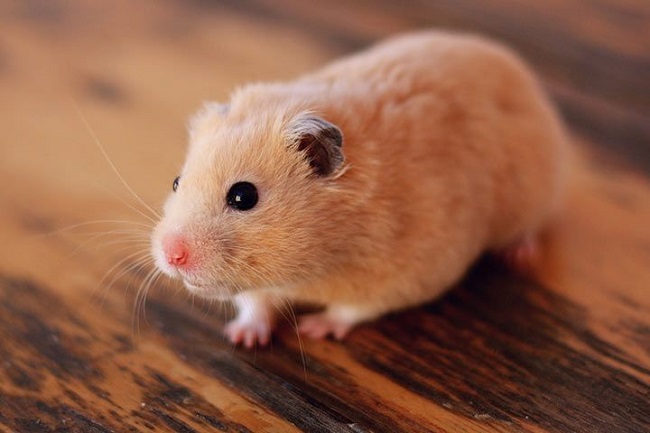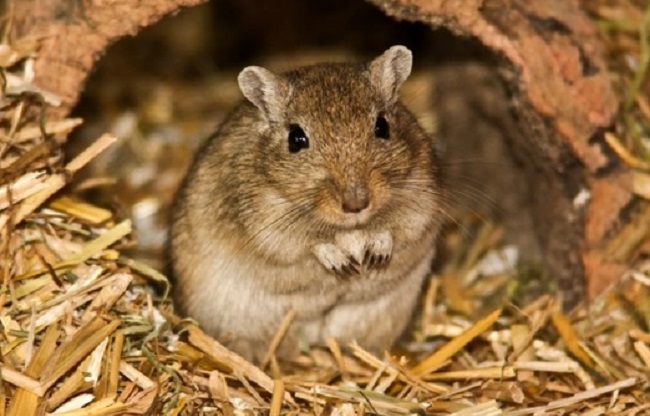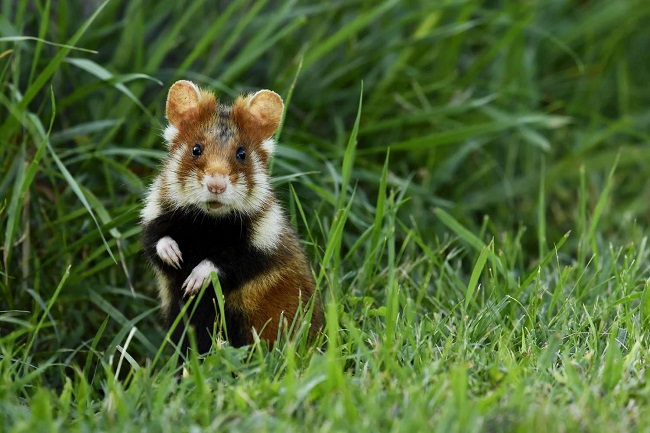Hamsters are among the most popular small pets, known for their adorable appearance and manageable size. These tiny rodents are not only cherished as pets but also play significant roles in scientific research due to their unique characteristics.
This article explores the top 33 types of hamsters in the world, highlighting their distinctive traits, habitats, and why they make great pets.
Exploring The Top 33 Types of Hamster Breeds Around the World
1. Syrian Hamster (Mesocricetus auratus)

The Syrian Hamster, also known as the Golden Hamster, is the most common pet hamster. These hamsters are known for their golden-brown fur and can grow up to 7 inches in length.
Syrian Hamsters are solitary animals and prefer to live alone. They are active and playful, making them excellent pets for both children and adults.
2. Dwarf Campbell Russian Hamster (Phodopus campbelli)
The Dwarf Campbell Russian Hamster is a small, social species that enjoys the company of its kind. These hamsters have grayish-brown fur with a distinctive dorsal stripe and grow up to 4 inches in length. They are known for their friendly and curious nature, making them great pets for those who enjoy interacting with their animals.
3. Roborovski Hamster (Phodopus roborovskii)
The Roborovski Hamster is the smallest and fastest of all hamster species, measuring just 2 inches in length. These tiny hamsters have sandy-colored fur and a white face. Roborovskis are very active and require a spacious cage with plenty of enrichment to keep them entertained. They are best suited for observation rather than handling due to their speed.
4. Chinese Hamster (Cricetulus griseus)
The Chinese Hamster is known for its long, slender body and tail, which gives it a mouse-like appearance. These hamsters grow up to 4 inches in length and have grayish-brown fur with a dark stripe along their back. Chinese Hamsters are agile climbers and enjoy exploring their environment. They are relatively calm and can make good pets with gentle handling.
5. Winter White Dwarf Hamster (Phodopus sungorus)
The Winter White Dwarf Hamster, also known as the Djungarian Hamster, is known for its ability to change fur color during the winter months, turning from gray-brown to white. These hamsters grow up to 4 inches in length and have a friendly and social nature. They can be housed in pairs or small groups if introduced properly.
6. European Hamster (Cricetus cricetus)
The European Hamster, also known as the Common Hamster, is one of the largest hamster species, growing up to 14 inches in length. These hamsters have a striking appearance with reddish-brown fur, white underparts, and black markings. They are native to Eastern Europe and are more suited to the wild than as pets due to their size and behavior.
7. Teddy Bear Hamster (Mesocricetus auratus)
The Teddy Bear Hamster is a variation of the Syrian Hamster known for its long, fluffy fur. These hamsters require regular grooming to keep their coats in good condition. They grow up to 7 inches in length and are known for their friendly and docile nature, making them excellent pets for children and adults alike.
8. Turkish Hamster (Mesocricetus brandti)
The Turkish Hamster, also known as the Brandt’s Hamster, is native to the regions of Turkey and Syria. These hamsters grow up to 7 inches in length and have a reddish-brown coat with a white belly. They are solitary animals and prefer to live alone. Turkish Hamsters are known for their robust build and energetic behavior.
9. Greater Long-tailed Hamster (Tscherskia triton)
The Greater Long-tailed Hamster is native to East Asia and is known for its long tail, which distinguishes it from other hamster species. These hamsters grow up to 6 inches in length and have brown fur with a lighter underbelly.
They are solitary and nocturnal, requiring a quiet environment during the day. Greater Long-tailed Hamsters are more suited to experienced hamster owners.
10. Desert Hamster (Phodopus roborovskii)
The Desert Hamster, also known as the Roborovski Dwarf Hamster, is adapted to arid environments. These tiny hamsters, reaching up to 2 inches in length, have sandy-colored fur that helps them blend into their desert surroundings.
They are highly active and need a spacious, enriched environment. Their small size and speed make them better suited for observation than handling.
11. Lesser Long-Tailed Hamster (Tscherskia triton)
The Lesser Long-Tailed Hamster, found in East Asia, is recognized for its long tail, which is unusual among hamsters. These hamsters grow up to 5 inches in length and have brown fur with a lighter underbelly. They are solitary and nocturnal, requiring a calm environment during the day. They are ideal for experienced hamster owners who can meet their specific needs.
12. Golden Hamster (Mesocricetus auratus)
The Golden Hamster is another name for the Syrian Hamster. These hamsters are well-loved for their friendly nature and manageable size, growing up to 7 inches in length. Golden Hamsters are solitary and prefer living alone. They are known for their golden-brown fur and make excellent pets for both children and adults due to their docile temperament.
13. Gansu Hamster (Cansumys canus)
The Gansu Hamster, native to the Gansu region in China, is a lesser-known species with distinct characteristics. These hamsters have grayish-brown fur and are adapted to the high-altitude environment of their native region. They are solitary animals and prefer living alone. Gansu Hamsters are known for their hardy nature and adaptability.
14. Striped Dwarf Hamster (Cricetulus barabensis)
The Striped Dwarf Hamster, also known as the Chinese Striped Hamster, is native to Northern China and Mongolia. These hamsters have a distinctive dark stripe running down their back and grow up to 4 inches in length. They are solitary and nocturnal, preferring to be active at night. Their friendly nature makes them good pets if handled gently.
15. Mongolian Hamster (Allocricetulus curtatus)

The Mongolian Hamster is a small, robust species native to Mongolia and parts of China. These hamsters have sandy-brown fur and grow up to 4 inches in length. They are adapted to the harsh conditions of the Mongolian steppes and are solitary by nature. Mongolian Hamsters are known for their resilience and hardy nature.
16. Eversmann’s Hamster (Allocricetulus eversmanni)
Eversmann’s Hamster, native to Central Asia, is known for its distinctive dark fur and white underbelly. These hamsters grow up to 5 inches in length and are solitary animals. They are nocturnal and prefer a quiet environment during the day. Eversmann’s Hamsters are relatively rare as pets but are valued for their unique appearance and hardy nature.
17. Sichuan Hamster (Cricetulus sichuanensis)
The Sichuan Hamster, native to the Sichuan region of China, is a small, hardy species adapted to high-altitude environments. These hamsters have grayish-brown fur and grow up to 4 inches in length. They are solitary and nocturnal, requiring a calm environment during the day. Sichuan Hamsters are known for their resilience and adaptability.
18. Chinese Striped Hamster (Cricetulus barabensis)
The Chinese Striped Hamster, native to northern China and Mongolia, is characterized by its dark dorsal stripe. These hamsters are small, growing up to 4 inches in length, and have grayish-brown fur. They are solitary and nocturnal, preferring a quiet environment during the day. Chinese Striped Hamsters are friendly and can be great pets if handled gently.
19. Tibetan Dwarf Hamster (Cricetulus tibetanus)
The Tibetan Dwarf Hamster is native to the high-altitude regions of Tibet. These small hamsters have a robust build and grayish-brown fur. They grow up to 4 inches in length and are known for their ability to adapt to harsh environments. Tibetan Dwarf Hamsters are solitary and make great pets for those who appreciate their resilience.
20. Ladak Hamster (Cricetulus ladakensis)
The Ladak Hamster, found in the mountainous regions of Ladakh, India, is a hardy species adapted to cold climates. These hamsters have thick, grayish-brown fur and grow up to 5 inches in length. They are solitary and nocturnal, requiring a quiet environment. Ladak Hamsters are valued for their unique appearance and adaptability.
21. Kazakh Hamster (Cricetulus migratorius)
The Kazakh Hamster, native to Kazakhstan and surrounding areas, is known for its migratory behavior. These hamsters have a robust build and sandy-brown fur. They grow up to 5 inches in length and are solitary animals. Kazakh Hamsters are hardy and adaptable, making them interesting pets for experienced owners.
22. Daurian Hamster (Phodopus roborovskii)
The Daurian Hamster, also known as the Roborovski Dwarf Hamster, is one of the smallest hamster species, growing up to 2 inches in length. These hamsters have sandy-colored fur and are incredibly active. They are best suited for observation due to their speed and small size. Daurian Hamsters require a spacious and enriched environment.
23. Altai Hamster (Phodopus sungorus)
The Altai Hamster, found in the Altai Mountains of Russia, is a small, hardy species known for its ability to change fur color in winter. These hamsters have grayish-brown fur that turns white in winter. They grow up to 4 inches in length and are friendly and social, making them good pets if housed properly.
24. Sakhalin Hamster (Cricetulus migratorius)
The Sakhalin Hamster, native to the Sakhalin Island in Russia, is adapted to cold climates. These hamsters have thick, grayish-brown fur and grow up to 5 inches in length. They are solitary and nocturnal, requiring a quiet environment. Sakhalin Hamsters are known for their resilience and hardy nature.
25. Kashmir Hamster (Cricetulus alticola)
The Kashmir Hamster, found in the mountainous regions of Kashmir, India, is a small, robust species adapted to high altitudes. These hamsters have grayish-brown fur and grow up to 4 inches in length. They are solitary and nocturnal, making them interesting pets for those who appreciate their unique adaptation to harsh environments.
26. Ussuri Hamster (Cricetulus barabensis)
The Ussuri Hamster, native to the Ussuri region of Russia, is known for its distinctive dark dorsal stripe. These small hamsters have grayish-brown fur and grow up to 4 inches in length. They are solitary and nocturnal, preferring a quiet environment. Ussuri Hamsters are friendly and can make great pets if handled gently.
27. Armenian Hamster (Mesocricetus brandti)
The Armenian Hamster, also known as Brandt’s Hamster, is native to Armenia and neighboring regions. These hamsters have golden-brown fur and grow up to 7 inches in length. Armenian Hamsters are solitary and nocturnal, requiring ample space and enrichment. They are known for their friendly nature and can make excellent pets with proper care.
28. Turkestan Hamster (Cricetulus migratorius)
The Turkestan Hamster is found in Central Asia, including regions of Turkestan. These hamsters have a sandy-brown coat and grow up to 5 inches in length. They are solitary and nocturnal, thriving in quiet environments. Turkestan Hamsters are known for their resilience and adaptability to various habitats.
29. Tibetan Hamster (Cricetulus tibetanus)
The Tibetan Hamster, native to the Tibetan Plateau, is a small, robust species known for its ability to survive in high-altitude environments. These hamsters have grayish-brown fur and grow up to 4 inches in length. They are solitary and nocturnal, requiring a calm environment. Tibetan Hamsters are valued for their resilience and adaptability.
30. Gobi Hamster (Phodopus roborovskii)
The Gobi Hamster, also known as the Roborovski Dwarf Hamster, is adapted to the arid conditions of the Gobi Desert. These tiny hamsters, reaching up to 2 inches in length, have sandy-colored fur. They are incredibly active and require a spacious, enriched environment. Gobi Hamsters are best suited for observation due to their speed and small size.
31. Turkmenistan Hamster (Cricetulus migratorius)

The Turkmenistan Hamster, native to Turkmenistan and surrounding regions, is a small, hardy species. These hamsters have sandy-brown fur and grow up to 5 inches in length. They are solitary and nocturnal, requiring a calm environment. Turkmenistan Hamsters are known for their resilience and adaptability to various habitats.
32. Dzungarian Hamster (Phodopus sungorus)
The Dzungarian Hamster, also known as the Winter White Dwarf Hamster, is known for its ability to change fur color during the winter months, turning from gray-brown to white.
These hamsters grow up to 4 inches in length and have a friendly and social nature. They can be housed in pairs or small groups if introduced properly.
33. Campbell’s Dwarf Hamster (Phodopus campbelli)
The Campbell’s Dwarf Hamster is a small, social species that enjoys the company of its kind. These hamsters have grayish-brown fur with a distinctive dorsal stripe and grow up to 4 inches in length. They are known for their friendly and curious nature, making them great pets for those who enjoy interacting with their animals.
Conclusion
These top 33 types of hamsters showcase the incredible diversity and adaptability of these charming rodents. From the popular Syrian Hamster to the tiny Roborovski Hamster, each species offers unique characteristics that make them special.
Understanding the needs and behaviors of these hamsters can help pet owners provide the best care and create a happy, healthy environment for their furry friends.
Whether you are a first-time hamster owner or an experienced enthusiast, there is a perfect hamster out there for everyone.
